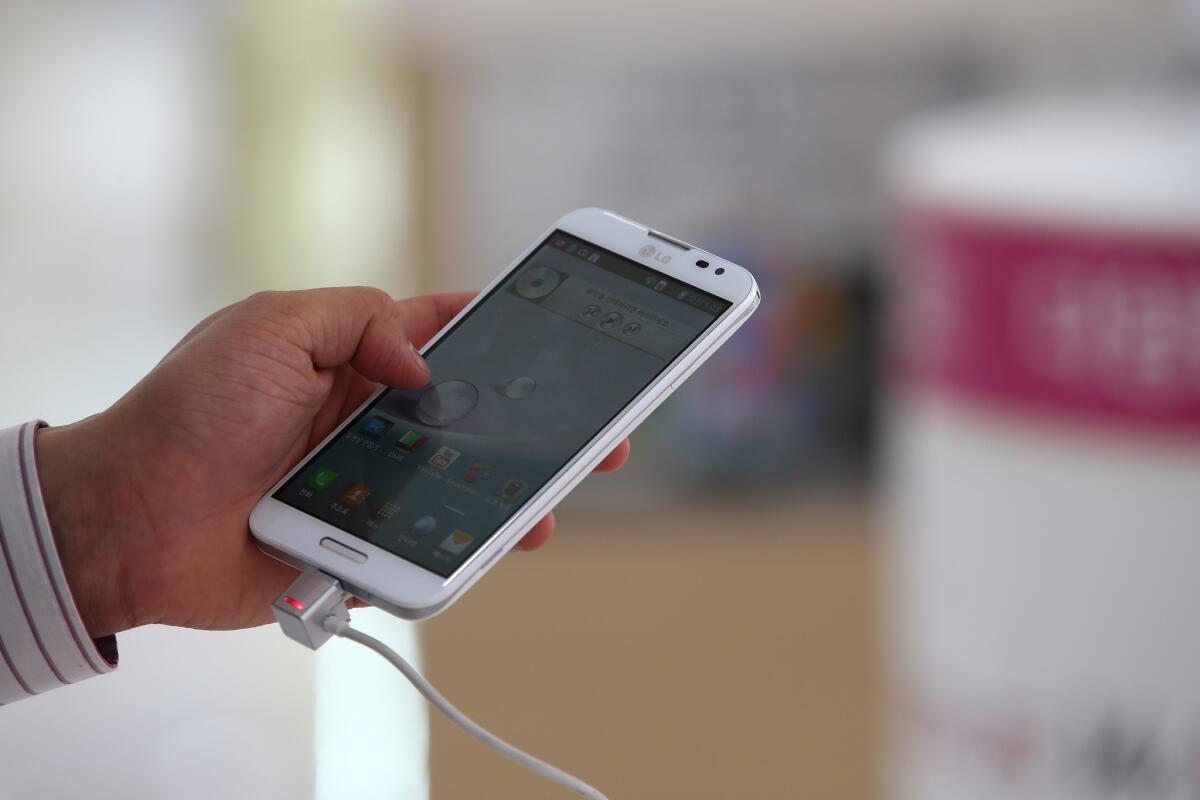5G is coming to Glendale, but not all residents welcome the ‘superfast’ cell network

- Share via
Glendale will be poised to tap into the faster cellular network known as 5G, amid a backlash from some local residents who say the technology carries health risks.
In late August, Glendale’s Public Works Department approved permits sought by AT&T for 23 small-cell wireless towers that will be installed in residential areas around the city, including near several schools.
The cell towers have 24-inch antennas and span 15 inches in diameter, AT&T representative Adrian Culici said during a public hearing on Aug. 6. Culici described them as a “dramatic decrease in bulk and in power” compared to “macro sites” that can rise 50- to 75-feet high.
Lower in power than the larger towers, these devices must be placed closer to target coverage areas — in this case, homes — to be effective, Culici said. Larger towers are usually installed in commercial or industrial areas, such as atop office buildings or on the sides of freeways.
A majority of the speakers at the hearing opposed the impending installation, with many suggesting that the radio-frequency energy that the devices emit is harmful. Burbank residents aired similar concerns during a town hall meeting in February.
Where the devices are installed, “birds are dying and bees are dying,” Irena Varjabedian said during the hearing. “You have [taken] an oath to help the people, which is us, not corporations, like AT&T… They are only after the money, they don’t care about our health.”
Stephen Dickinson, chief business and financial officer with the Glendale Unified School District, singled out four project sites that district officials are concerned about due to their proximity to local schools. He asked that alternatives to the sites be reconsidered.
Culici said later that likely won’t happen because the devices must be within 250 feet of a center target, so any readjustment would be minimal.
Since 1996, the Federal Communications Commission, or FCC, reported it has required that all wireless communication devices sold in the United States meet its minimum guidelines for safe human exposure to radio frequency energy.
“Some health and safety interest groups have interpreted certain reports to suggest that wireless device use may be linked to cancer and other illnesses, posing potentially greater risks for children than adults,” the FCC reports on its website. “While these assertions have gained increased public attention, currently no scientific evidence establishes a causal link between wireless-device use and cancer or other illnesses.”
There is consensus that more and longer-term studies are needed to explore the effects of exposure to radio frequency energy, the FCC website states.
“It’s very concerning that we’re all guinea pigs in an experiment,” Topanga resident Julie Levine said in a follow-up phone interview after the meeting.
Levine, who runs a group called 5G Free CA, said she would like Glendale City Council members to pass an emergency ordinance barring the installation of the towers within 1,000 feet of homes.
Glendale has already developed an ordinance governing wireless-facility installations “to the extent possible,” according to Glendale’s rumor page on its website, which addresses perceived misconceptions concerning city affairs.
Because AT&T is a licensed wireless provider that abides by state and federal laws — as well as regulations set by the FCC — the city has limited discretion over the approval process, according to Mayor Ara Najarian.
“It’s a highly regulated field,” he said, adding that the city is barred by FCC regulations from taking health concerns into consideration when approving the permits. The city can regulate aesthetic guidelines and fees.
Some cities — like Fairfax and Mill Valley in Northern California — have pushed back against the FCC with more stringent ordinances, Levine and others said.
Glendale resident Charles Sayles said he supported 5G because he thinks it has the potential to revolutionize the medical profession, including enhancing surgical procedures.
“If we give up 5G, we may give up that kind of capability,” he said during the public hearing, amid jeers from some people in the audience.
Sidestepping issues of life and death, Culici said AT&T’s current networks are simply at capacity and need to expand to accommodate demand.
Since 2006, there’s been a 470,000% increase in the data traffic on AT&T networks, Culici said. As of three years ago, 50% of the population reported being totally wireless, he added.
“The end result of all of this increase in data usage has been that network capacity is shrinking at an ever-increasing rate,” he said.
For each device, the city receives $1,500 in fees annually, according to a chart provided by city spokeswoman Eliza Papazian. There is also a one-time $800 application-processing fee for each device.
One site, at 283 Maryland Place, has been appealed. The deadline to file an appeal was Sept. 4.
